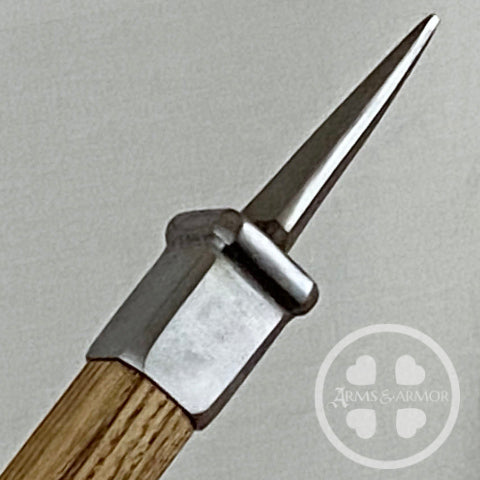Historically, the design of the glaive was characterized by a single-edged blade attached to a pole, creating a versatile weapon that could be used for cutting, thrusting, and slicing. The glaive has roots in both agricultural tools and earlier polearm designs

Butt Spike
Origins and Evolution -
The glaives origins can be traced back to the early medieval period, though this elegant style of polearm's creation is difficult to identify as it is claimed by everyone from the Welsh in the west to the Hungarians in the east. Its earliest forms are seen in art from the mid 13th century and are seen alongside other early forms of hafted weapons, all of which probably count the spear and agricultural tools as their genesis.
Over time, the glaive evolved with various designs and regional variations. The typical glaive consisted of a long haft with a single or double edged blade affixed to one end. The blade was usually convex edged in shape and designed for hewing and thrusting.


Historical glaives
Use in Warfare -
Glaives were widely used across medieval Europe, particularly during the 14th and 15th centuries. They were often seen among infantry being depicted in many battle and siege scenes in art of the period. Their effectiveness against opponents wearing armor, along with their extended reach made them a sound choice of many knights. The versatility of the armored man bearing a glaive probably contributed to the French nickname of Breach Knife for this valuable battlefield weapon.
As you can see below, these weapons were excellent for exploiting the weak points of period armors...

We seem to have identified a distinct use of the glaive not often mentioned.

The Tard-Venus pillage Grammont in 1362, from Froissart's Chronicles.
Variations -
There are many variations of the glaive such as the fauchard and the glaive-guisarme. The fauchard had a blade with a pronounced curve, while the glaive-guisarme featured a hook or spike on the reverse side of the blade, adding utility in disarming or tripping opponents. .
Transition to Ceremonial Weapon -
As the Renaissance began to flourish and the nobility strived to display their wealth and stature, the use of traditional polearms like the glaive often resulted in highly decorative versions. So we see the glaive persisting as a ceremonial weapon and a symbol of authority even into the present. Guards and ceremonial troops in various European countries still carry ornate glaives.
Pop Culture -
The glaive's distinctive appearance and historical significance have made it a popular choice in fantasy literature, movies, and video games. Titles such as Final Fantasy and World of Warcraft have these iconic weapons as mainstays.







